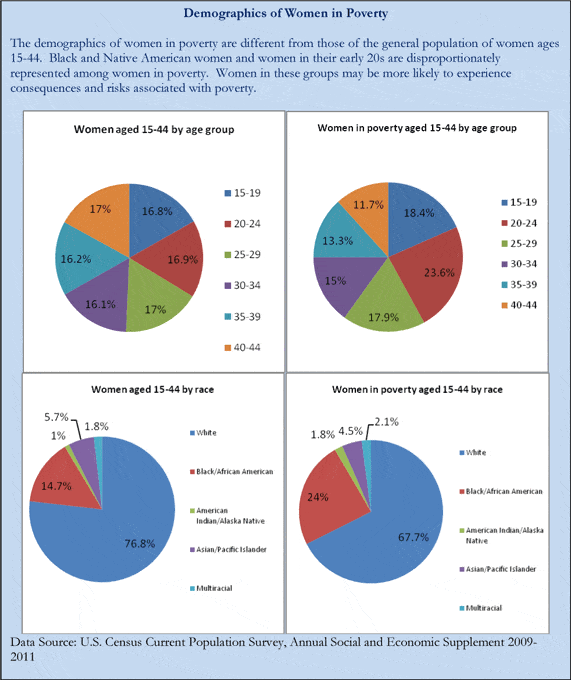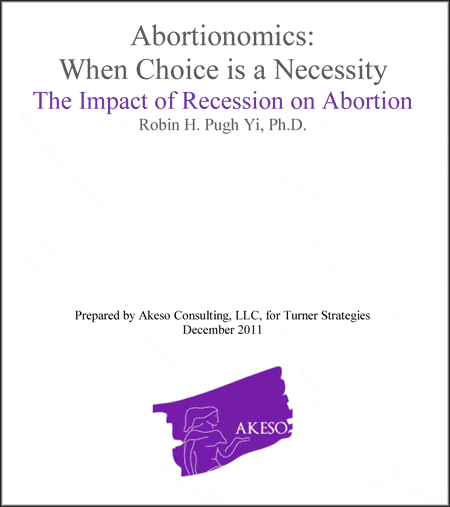by The Editors
A new study puts another face on women’s reproductive decision-making during an economic downturn. It indicates that low-income women increasingly are being forced to “choose” abortions out of economic need.
Conducted by independent researcher Robin H. Pugh Yi, Ph.D., president of Akeso Consulting in Vienna, Virginia, the study is called Abortionomics: When Choice Is a Necessity, The Impact of Recession on Abortion. The analysis was commissioned by Merle Hoffman, founder and president of Choices Women’s Medical Center, after hearing anecdotal information from abortion patients that today’s economic hardships were a large factor in women’s decisions to have abortions. The findings were presented by Hoffman and Pugh Yi at the National Press Club in Washington D.C. on Jan. 17, 2011.
On one hand, it seems obvious: When the economy dips, it’s harder for people to raise a family. But this living reality, borne out in the report’s data, remains outside today’s heated political debates about abortion and birth control. As a result, too many politicians seem oblivious to the consequences of unwanted pregnancies and, when carried to term, the resulting births that impose difficult, if not impossible, financial burdens on already strapped mothers and families.
Follow-Up to Reagan-Era Report
The new report is actually a follow-up to a 1980s study undertaken by Hoffman and Choices in partnership with Adelphi University. Hoffman titled it “Abortionomics” because it showed that high numbers of women who were having abortions did so because they couldn’t afford not to. In addition, more than half of those responding to the earlier survey said they would do “whatever it took” to have an abortion, even if abortion were illegal. The stark conclusion is that they were willing to risk their very lives to have unsafe abortions if that were the only option, a risk that many women have been forced to make when abortion is illegal or inaccessible.
The newly-released report, some 30 years later, shows similar economic concerns driving the reproductive decisions of women, men and families today. (Entire report available, here.)
The current research pointed to three key findings. First, as the economic downturn continued, birth rates fell and the demand for contraceptive services, including vasectomies, increased.
Second, as economic factors forced cutbacks in social services, low-income women faced greater difficulties in getting safe and affordable birth control.
Third, faced with these difficulties, more low-income women were choosing abortion. The report cites findings from the well-regarded Guttmacher Institute, showing that in 2008, the last year for which national figures are available, 69 percent of women having abortions were living at incomes lower than 200 percent of the federal poverty line, compared to 35 percent of women in the general population. In addition, 42 percent of abortion patients lived below the federal poverty line in 2008 compared to 27 percent in 2000.
The new report also draws upon the experience of local providers and non-profits that assist low income women to show the rise in abortion demand during today’s economically-pressured times. It notes, for example, that Oakland’s ACCESS, which serves only low-income clients, reported that 60 percent of all calls received in 2008 were from women seeking abortions; in 2009, the number increased to 72 percent of all calls.
The National Network of Abortion Funds, an organization that provides financial support for women who cannot afford the cost of an abortion, reported that calls to its helpline nearly quadrupled from 2008 and 2009.
Finally, at Choices Women’s Medical Center in New York City, demand for abortion services increased four percent from 2008 to 2009, while the number of economically disadvantaged women requesting abortions increased by eight percent in that same time period.
Decreasing Abortion Means Improving Health Care, Economic Stability
The report concludes:
“Given the consistent findings that economics are a critical component in choices regarding abortion, the most effective approach to decreasing abortion rates will involve increased access to comprehensive health care and expanding opportunities for employment and economic stability.
“Barring this, as the economy declines, demand for abortion can be expected to increase. Available data suggest that demand is increasing and access is declining. Many women report that they believe economics would force them to choose abortion, regardless of whether it is legal.
“Roe v. Wade resulted in a dramatic 90 percent reduction of abortion-related deaths between 1965 and 1975, with the low rate remaining stable since. The combination of a declining economy, decreased access to preventive birth control, and diminished access to safe and legal abortion services could well lead to a reversal of this trend. Responsible decision-making regarding health care, abortion, and economic policy must consider how these issues ultimately will impact the reproductive choices, including abortion – legal or not – that individuals must make.”

Also see “Abortion” by The Editors in this edition of On The Issues Magazine.
See “From Our Files, Related Stories: Bold Discussions of ABORTION” in this edition of On The Issues Magazine.
Also see “Where the Reality of Abortion Resides” by Merle Hoffman in this edition of On The Issues Magazine.
See “Occupying the Waiting Room: 40 Years of Health Care Needs” by Lori Adelman in this edition of On The Issues Magazine.
Read the Cafe for new and updated stories.

